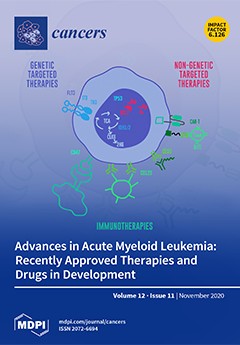Open AccessArticle
Evidences of a Direct Relationship between Cellular Fuel Supply and Ciliogenesis Regulated by Hypoxic VDAC1-ΔC
by
Monique Meyenberg Cunha-de Padua, Lucilla Fabbri, Maeva Dufies, Sandra Lacas-Gervais, Julie Contenti, Charles Voyton, Sofia Fazio, Marie Irondelle, Baharia Mograbi, Matthieu Rouleau, Nirvana Sadaghianloo, Amandine Rovini, Catherine Brenner, William J. Craigen, Jérôme Bourgeais, Olivier Herault, Frédéric Bost and Nathalie M. Mazure
Cited by 8 | Viewed by 2243
Abstract
Metabolic flexibility is the ability of a cell to adapt its metabolism to changes in its surrounding environment. Such adaptability, combined with apoptosis resistance provides cancer cells with a survival advantage. Mitochondrial voltage-dependent anion channel 1 (VDAC1) has been defined as a metabolic
[...] Read more.
Metabolic flexibility is the ability of a cell to adapt its metabolism to changes in its surrounding environment. Such adaptability, combined with apoptosis resistance provides cancer cells with a survival advantage. Mitochondrial voltage-dependent anion channel 1 (VDAC1) has been defined as a metabolic checkpoint at the crossroad of these two processes. Here, we show that the hypoxia-induced cleaved form of VDAC1 (VDAC1-ΔC) is implicated in both the up-regulation of glycolysis and the mitochondrial respiration. We demonstrate that VDAC1-ΔC, due to the loss of the putative phosphorylation site at serine 215, concomitantly with the loss of interaction with tubulin and microtubules, reprograms the cell to utilize more metabolites, favoring cell growth in hypoxic microenvironment. We further found that VDAC1-ΔC represses ciliogenesis and thus participates in ciliopathy, a group of genetic disorders involving dysfunctional primary cilium. Cancer, although not representing a ciliopathy, is tightly linked to cilia. Moreover, we highlight, for the first time, a direct relationship between the cilium and cancer cell metabolism. Our study provides the first new comprehensive molecular-level model centered on VDAC1-ΔC integrating metabolic flexibility, ciliogenesis, and enhanced survival in a hypoxic microenvironment.
Full article
►▼
Show Figures






